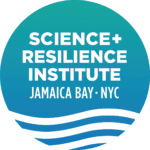Founded to bring a new model of collaboration to critical environmental challenges, the Science and Resilience Institute brings together community members, researchers, scientists, policy experts and others in the interest of building resilience and sustainability within the Jamaica Bay watershed and beyond.
The Institute is a partnership among the National Park Service, the City of New York, and the City University of New York (CUNY) acting on behalf of a Consortium of seven other research institutions: Columbia University, Cornell University, Rutgers University, Stony Brook University, New York Sea Grant, Stevens Institute of Technology, and the Wildlife Conservation Society.
Our mission is to produce integrated knowledge that increases biodiversity, well-being, and adaptive capacity in coastal communities and waters surrounding Jamaica Bay and New York City.
The Institute is hosted and supported by Brooklyn College working closely with other CUNY colleges.
History
The City of New York and the National Park Service came together in 2012 to sign an agreement to co-manage Jamaica Bay and restore roughly 10,000 acres of public parks, green spaces and watershed for educational, recreational and ecosystem purposes. The priority of this initiative was highlighted most recently in the Office of Resilience and Recovery’s A Stronger, More Resilient New York, New York City’s comprehensive plan to strengthen the city’s infrastructure and protect our communities against severe weather. Interior Secretary Sally Jewell has additionally recognized the importance of the Jamaica Bay partnership as an extension of President Obama’s America’s Great Outdoors Initiative. The vision for a grand, unified park that underpins this partnership has many components, including the establishment of a world-class institute to facilitate an exchange of information among scientists, managers, policymakers, and community leaders on issues of coastal and urban resiliency relevant to cities around the world.
The expansion of these actions and commitments coincided with ongoing efforts of interested scientists and researchers, community leaders, decision-makers, and stakeholders who were already beginning to think about how disturbances in the Jamaica Bay social and ecological systems could disrupt or lead to negative changes in the region. In each of these efforts was the impetuous for systematically trying to assess and understand how to make the system more resilient to potential disturbances. Thus, even as Sandy moved up the Atlantic seaboard in October of 2012, the groundwork was already being set for the establishment of the Science and Resilience Institute at Jamaica Bay. This new institute was intended to provide a home for much of the important applied research now underway in the region – bringing together scientists and policymakers committed not only to restoring the Bay, but also to using it as a place to explore broader issues of coastal resilience.
That goal has taken on even greater urgency in the wake of the Hurricane Sandy’s impact. The hurricane is a reminder that action is needed now. It also has focused greater attention and funding on the Jamaica Bay region and represents a historic moment for science engagement. In response, science, policy, and community actors have come together to create SRI@JB to nurture and support world-class research on the resilience of Jamaica Bay that can inform management both of the Bay and elsewhere. The City of New York and National Park Service have partnered in this endeavor with a consortium led by the City University of New York and including many of the area’s research universities as well as key local institutions.






